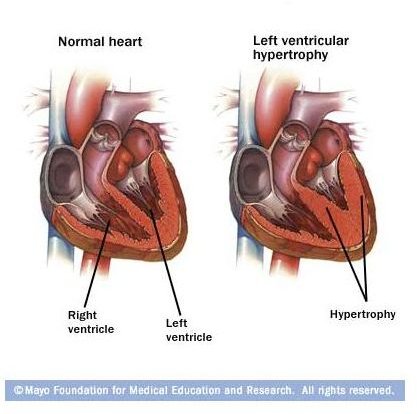Longevity with Left Ventricular Hypertrophy
Introduction
Left ventricular hypertrophy, or LVH, is defined by the Mayo Clinic as an “enlargement (hypertrophy) of the muscle tissue that makes up the wall of [the] heart’s main pumping chamber (left ventricle).” The left ventricle’s muscle tissue increases as a response

to the heart needing to pump more blood. However, the Mayo Clinic states that over time “the walls of the
chamber grow thicker, lose elasticity and eventually may fail to pump with as much force as a healthy heart.” As a result, the patient has an increased risk of having a heart attack, arrhythmia or sudden cardiac arrest. The patient’s quality of life is also affected by left ventricular hypertrophy. If the cause of left ventricular hypertrophy is not treated, the patient’s risk of death increases.
Causes
The Mayo Clinic notes that the causes of left ventricular hypertrophy force the heart to pump more blood; examples include hypertension, aortic valve stenosis, aortic valve regurgitation, dilated cardiomypathy and a heart attack. Each of these causes forces the muscles to work harder and cause damage to the heart. Hypertension, or high blood pressure, is defined as a systolic pressure of 140 mm Hg or above and diastolic pressure of 90 mm Hg or above. Aortic valve stenosis is a condition where the aortic valve is narrowed, preventing normal blood flow from the left ventricle. Aortic valve regurgitation involves a dysfunction of the heart valve between the aorta and left ventricle; this results in blood flowing back into the left ventricle. Dilated cardiomypathy is another heart condition where the left ventricle is enlarged; due to the larger size of the ventricle, more blood accumulates, which forces the left ventricle to work harder. Patients who have a heart attack have scarring of the muscle tissue, which results in the other muscles to compensate.
Longevity and Quality of Life
Zahler R. et al, authors of the article “Heterogeneous signal intensity in magnetic resonance images of hypertrophied left ventricular myocardium,” state that patients with left ventricular hypertrophy have a decreased longevity due to complications like congestive heart failure. Other conditions that can result from left ventricular hypertrophy that decreases the patient’s longevity include heart attack, ischemic heart disease, sudden cardiac arrest, arrhythmia and heart failure, according to the Mayo Clinic.
The patient’s quality of life is also affected by left ventricular hypertrophy, with symptoms including chest pain, shortness of breath, dizziness, palpitations, and fainting. The Mayo Clinic adds that when the patient does physical activity, such as exercise, she experiences rapid exhaustion. The combination of symptoms may limit which activities the patient participates in.
Treatment of Left Ventricular Hypertrophy
However, patients can decrease their risks by treating the underlying cause of their left ventricular hypertrophy. If high blood pressure is the cause, the doctor may prescribe blood pressure drugs, like thiazide diuretics, calcium channel blockers, beta blockers, angiotensin-converting enzyme inhibitors and angiotensin II receptor blockers; the Mayo Clinic adds that these drugs may reverse muscle growth in the left ventricle. If the cause is aortic valve stenosis or aortic valve regurgitation, surgery can repair or replace the valve.